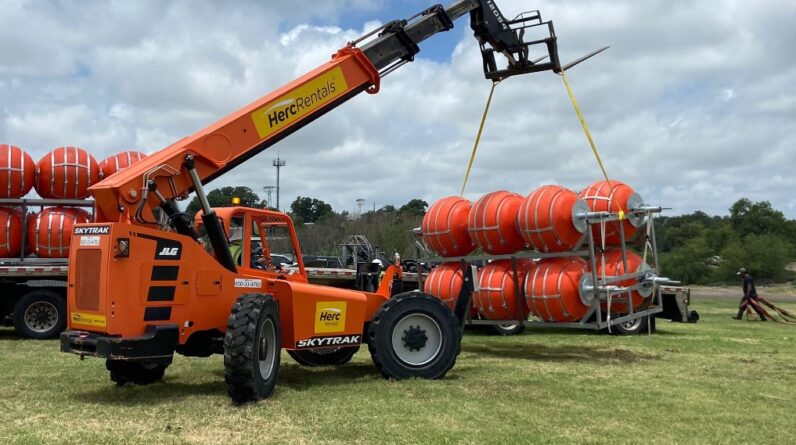
[ad_1]
Installation of the marine barrier on the Rio Grande began July 7, 2023.
Source – Texas Department of Public Service.
Texas began rolling out what is set to become a new floating barrier on the Rio Grande on Friday – huge orange buoys.
This is just the latest escalation in Texas Governor Greg Abbott’s multibillion-dollar effort to secure the U.S. border with Mexico, which already has included bussing migrants to liberal states and authorizing the National Guard to make arrests.
Earlier efforts to stop migrants from crossing the border have included installing miles of razor wire at popular crossing points on the river and creating state checkpoints beyond federal stops to inspect incoming commercial traffic, notes the Associated Press.
Governor Abbott announced the plan to install a floating barrier along the Rio Grande to deter illegal crossings at the US-Mexico border, during a bill signing in Austin, Texas on June 8.
“This is a new water-based barrier … we can put mile after mile after mile of these buoys,” the governor said while showing an artist’s illustration of the buoy barrier. “What we are doing right now, we are securing the border at the border – what these buoys will allow us to do is to prevent people from even getting to the border,” he added, reports CNN News.
Setting up the barriers could take up to two weeks, according to Lt. Chris Olivarez, a spokesperson for the Texas Department of Public Safety overseeing the project. Once installed, the above-river parts of the system and the webbing they’re connected with will cover 1,000 feet (305 meters) of the middle of the Rio Grande, with anchors in the riverbed.
The marine water barrier is being deployed in the river near the border town of Eagle Pass. The governor said in a Friday tweet. The Eagle Pass sector has seen the second-highest number of migrant crossings this fiscal year with about 270,000 encounters.
“We always look to employ whatever strategies will be effective in securing the border,” Abbott said in a June 8 press conference to introduce the buoy strategy. However, the state hasn’t said what tests or studies have been done to determine risks posed to people who try to get around the barrier or environmental impacts.
Violation of International Treaty
Additionally, the federal International Boundary and Water Commission, whose jurisdiction includes boundary demarcation and overseeing U.S.-Mexico treaties, said it didn’t get a heads-up from Texas about the proposed floating barrier.
The Treaty to Resolve Pending Boundary Differences and Maintain the Rio Grande and Colorado River as the International Boundary was signed in 1970, and sets limits on how the two countries can manage the Rio Grande.
Most particularly, the treaty prevents any one country from unilaterally taking measures that would displace the boundary or impair its integrity. Any such measures, including the construction of levees or other barriers along the river in its reach from El Paso to Brownsville, require the approval of both the U.S. and Mexican governments.
This is not the first time Abbott has ignored international law. He looked the other way when 9n 2019, the now notorious We Built the Wall group (of Steve Bannon fame) built bollard-style fencing on the banks of the Rio Grande without checking to see if it was even legal.
It’s not at all clear just how Abbott’s team intends to place the bobbing barrier and whether it can reliably sit just shy of the river’s center in U.S. sovereign jurisdiction, or whether it impedes the IBWC’s ability to manage the boundary channel.
[ad_2]
Source link






